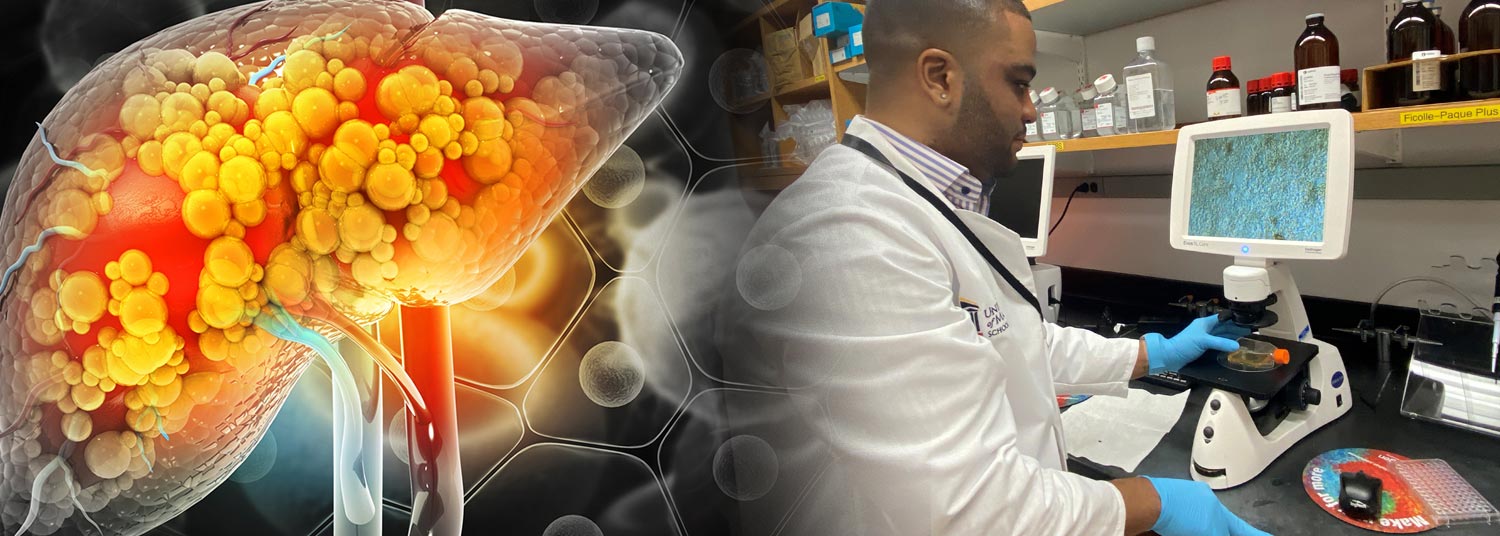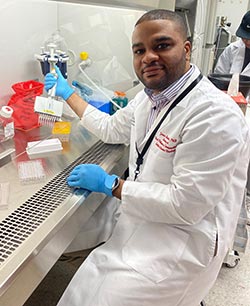June 26, 2023 | Vanessa McMains

More than 30 million people live with HIV infection, with some 73% on antiretroviral therapy (ART), which has allowed those infected to live longer. Although the infected’s virus levels are suppressed, current therapies do not fully restore health, and chronic inflammation persists.
 “People living with controlled HIV infection remain at increased risk for developing numerous morbidities, with liver fibrosis [scarring] or hepatocellular carcinoma [liver cancer] as leading — often fatal — complications,” said Lishan Su, PhD, Charles Gordon Smith Professor for HIV Research; Professor of Pharmacology; Director of the Division of Virology, Pathogenesis, and Cancer; and Interim Director of the Division of Immunotherapy at the University of Maryland School of Medicine’s (UMSOM) Institute of Human Virology (IHV). “New targets and strategies are urgently needed to combat such complications.”
“People living with controlled HIV infection remain at increased risk for developing numerous morbidities, with liver fibrosis [scarring] or hepatocellular carcinoma [liver cancer] as leading — often fatal — complications,” said Lishan Su, PhD, Charles Gordon Smith Professor for HIV Research; Professor of Pharmacology; Director of the Division of Virology, Pathogenesis, and Cancer; and Interim Director of the Division of Immunotherapy at the University of Maryland School of Medicine’s (UMSOM) Institute of Human Virology (IHV). “New targets and strategies are urgently needed to combat such complications.”
Until recently, researchers did not understand how exactly the virus still wreaks havoc in the body, even when it is at virtually undetectable levels. James Ahodantin, PhD, Research Associate of Pharmacology in the Division of Virology, Pathogenesis, and Cancer at the IHV in Dr. Su’s laboratory, decided to dig deeper into the cell and molecular mechanism behind HIV-induced liver disease.
His research led to identifying two different factors involved in liver damage that researchers hope will direct targets towards treatment and prevention. The findings were published last year in JCI Insight.
 Dr. Ahodantin started his investigation using “humanized” mice — mice with their immune systems replaced with human ones. These mice were infected with HIV and treated 4-6 weeks later with a similar combination of antiretroviral therapy taken by patients with HIV. After about three or four months, Dr. Ahodantin checked the mice’s livers and blood, which already had inflammation (i.e., hepatitis) and markers for liver tissue injury.
Dr. Ahodantin started his investigation using “humanized” mice — mice with their immune systems replaced with human ones. These mice were infected with HIV and treated 4-6 weeks later with a similar combination of antiretroviral therapy taken by patients with HIV. After about three or four months, Dr. Ahodantin checked the mice’s livers and blood, which already had inflammation (i.e., hepatitis) and markers for liver tissue injury.
“As for identifying the mechanism, we knew that HIV infection, even with effective antiretroviral therapy, still leads to persistent type I interferon (IFN-I) production. That made us wonder why it was still there months, even years later in patients and what its impact was,” said Dr. Ahodantin. “Interferons are released by cells when they detect a virus to ramp up the body’s antiviral defenses. If the interferon amount isn’t regulated correctly or is produced chronically, interferon itself can become pathogenic.”
They found notably higher levels of interferons in the livers from their humanized mice with treated HIV infections. Next, they treated liver stellate cells — which are a type of liver cell that play a vital role in liver function and scar tissue formation — from healthy donors with interferons, which turned on damage markers that led to liver scarring, confirming their suspicions that interferons played a role.
In the humanized mice with HIV treated with antiretroviral therapy, the researchers also observed that immune cells had infiltrated into the liver. When they analyzed what kind they were, Dr. Ahodantin found they were primarily macrophages with M2 characteristics. What characterizes M2 macrophages are high levels of production of a cytokine, an immune system regulator, called Transforming Growth Factor-β (TGF-β), which has been reported to be the “master of liver disease.” When the researchers added both interferons and TGF-β to liver stellate cells, the damage markers for liver scarring were much more pronounced than with interferons or TGF-β alone.
Even though interferons and TGF-β seemed to be both implicated in HIV-induced liver disease, when the team used an antibody to block a receptor for interferons, the humanized mice with HIV on antiretroviral therapy no longer had scarring in their livers. The TGF-β producing M2-like macrophages also disappeared. Working with IHV’s Division of Clinical Care and Research, the team confirmed these results in blood samples and liver biopsies from patients.
“Currently there are no effective drugs for treating people living with HIV-associated liver diseases, although several drugs targeting type 1 interferons or TGF-β/M2 macrophages are being developed to treat other diseases,” said Dr. Su.
“This finding has opened a possibility that we may be able to prevent or treat liver damage by finding another therapy that targets M2 macrophages or blocks interferons to treat liver disease in people living with HIV,” added Dr. Ahodantin.
Dr. Ahodantin has several projects in the works determining how viruses affect the liver. In a related project, he showed that HIV and hepatitis B viruses induce the conversion of proinflammatory M1 macrophages to M2 macrophages, which instead are immunosuppressive. He speculates that this metabolic switch allows viruses to escape the immune response.
About the Institute of Human Virology
 Formed in 1996 as a partnership between the State of Maryland, the City of Baltimore, the University System of Maryland, and the University of Maryland Medical System, the IHV is an institute of the University of Maryland School of Medicine and is home to some of the most globally recognized and world-renowned experts in all of virology.
Formed in 1996 as a partnership between the State of Maryland, the City of Baltimore, the University System of Maryland, and the University of Maryland Medical System, the IHV is an institute of the University of Maryland School of Medicine and is home to some of the most globally recognized and world-renowned experts in all of virology.
The IHV combines the disciplines of basic research, epidemiology, and clinical research in a concerted effort to speed the discovery of diagnostics and therapeutics for a wide variety of chronic and deadly viral and immune disorders, most notably HIV, the virus that causes AIDS. For more information, visit ihv.org and follow us on Twitter @IHVmaryland.
About the University of Maryland School of Medicine
Now in its third century, the University of Maryland School of Medicine was chartered in 1807 as the first public medical school in the United States. It continues today as one of the fastest growing, top-tier biomedical research enterprises in the world — with 46 academic departments, centers, institutes, and programs, and a faculty of more than 3,000 physicians, scientists, and allied health professionals, including members of the National Academy of Medicine and the National Academy of Sciences, and a distinguished two-time winner of the Albert E. Lasker Award in Medical Research. With an operating budget of more than $1.3 billion, the School of Medicine works closely in partnership with the University of Maryland Medical Center and Medical System to provide research-intensive, academic, and clinically based care for nearly 2 million patients each year. The School of Medicine has nearly $600 million in extramural funding, with most of its academic departments highly ranked among all medical schools in the nation in research funding. As one of the seven professional schools that make up the University of Maryland, Baltimore campus, the School of Medicine has a total population of nearly 9,000 faculty and staff, including 2,500 students, trainees, residents, and fellows. The combined School of Medicine and Medical System (“University of Maryland Medicine”) has an annual budget of over $6 billion and an economic impact of nearly $20 billion on the state and local community. The School of Medicine, which ranks as the 8th highest among public medical schools in research productivity (according to the Association of American Medical Colleges profile) is an innovator in translational medicine, with 606 active patents and 52 start-up companies. In the latest U.S. News & World Report ranking of the Best Medical Schools, published in 2021, the UM School of Medicine is ranked #9 among the 92 public medical schools in the U.S., and in the top 15 percent (#27) of all 192 public and private U.S. medical schools. The School of Medicine works locally, nationally, and globally, with research and treatment facilities in 36 countries around the world. Visit medschool.umaryland.edu
Contact
Vanessa McMains
Director, Media & Public Affairs
University of Maryland School of Medicine
Institute of Human Virology
vmcmains@ihv.umaryland.edu
Cell: 443-875-6099
